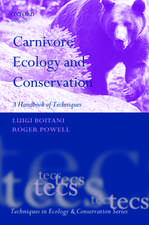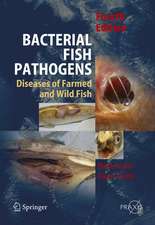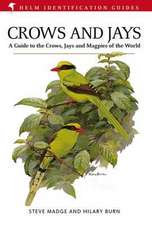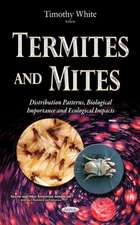Biology of the Integument: Invertebrates
Editat de J. Bereiter-Hahn, A.G. Matoltsy, K. S. Richardsen Limba Engleză Paperback – 19 iul 2012
| Toate formatele și edițiile | Preț | Express |
|---|---|---|
| Paperback (2) | 674.42 lei 6-8 săpt. | |
| Springer Berlin, Heidelberg – 3 dec 2014 | 674.42 lei 6-8 săpt. | |
| Springer Berlin, Heidelberg – 19 iul 2012 | 976.86 lei 6-8 săpt. |
Preț: 976.86 lei
Preț vechi: 1191.29 lei
-18% Nou
Puncte Express: 1465
Preț estimativ în valută:
186.95€ • 194.45$ • 154.33£
186.95€ • 194.45$ • 154.33£
Carte tipărită la comandă
Livrare economică 15-29 aprilie
Preluare comenzi: 021 569.72.76
Specificații
ISBN-13: 9783642515958
ISBN-10: 3642515959
Pagini: 864
Ilustrații: XVI, 844 p.
Dimensiuni: 170 x 244 x 45 mm
Greutate: 1.35 kg
Ediția:Softcover reprint of the original 1st ed. 1984
Editura: Springer Berlin, Heidelberg
Colecția Springer
Locul publicării:Berlin, Heidelberg, Germany
ISBN-10: 3642515959
Pagini: 864
Ilustrații: XVI, 844 p.
Dimensiuni: 170 x 244 x 45 mm
Greutate: 1.35 kg
Ediția:Softcover reprint of the original 1st ed. 1984
Editura: Springer Berlin, Heidelberg
Colecția Springer
Locul publicării:Berlin, Heidelberg, Germany
Public țintă
Professional/practitionerDescriere
The integument plays an important role in the survival of meta zoans by separating and protecting them from a hostile environ ment. Its function ranges from protection against injury and in fection; partlcipation in the regulation of body temperature and water balance, to respiratory activity, monitoring of the environ ment and production of signals related to behaviour. All these result from specific structural, biochemical and physiological properties of intra-and extracellular components of the integu ment. Thus its characterization can be best accomplished by a multidisciplinary approach with authors specialized in different fields of science. This multi-author book, in two volumes, provides an up-to date survey of the literature. The first volume deals with the integument of invertebrates, the second with that of vertebrates, both organized primarily on a phylum basis. As the level of knowledge on the integument of phyla differs considerably, the information provided is correspondingly either limited or con densed. For some of the smaller groups of invertebrates little information is available, as often only a few electron micrographs are to be found in the literature; on the other hand, from the large body of knowledge existing for vertebrates, particularly for mammals, no complete overview can be provided, but publica tions giving access to further information have been reviewed critically.
Cuprins
I Introduction, Intercellular Junctions and Cilia.- 1 Introduction.- 2 Intercellular Junctions.- 2.1 Introduction.- 2.2 Desmosomes.- 2.3 Gap Junctions.- 2.4 Septate Junctions.- 2.5 Tricellular Junctions.- 2.6 Tight Junctions.- 3 Cilia.- 3.1 Introduction.- 3.2 Ciliary Beat Patterns.- 3.3 Ciliary Structure.- 3.4 Mechanisms of Ciliary Motility.- 3.5 Control of Ciliary Activity.- II The Diploblastic Level.- 4 Introduction to the Diploblastic Level.- 5 Cnidaria: Cell Types.- 5.1 Introduction.- 5.2 Epithelial Cells.- 5.3 Mucous Cells.- 5.4 Nerve Cells.- 5.5 Sense Cells.- 5.6 Interstitial Cells.- 6 Cnidaria: Cnidae.- 6.1 Introduction.- 6.2 Terminology.- 6.3 The Structure of Cnidae.- 6.4 The Functioning of Cnidae.- 6.5 The Functions of Cnidae.- 6.6 The Chemistry of Cnidae.- 6.7 Conclusions.- 7 Cnidaria: Secreted Surface.- 7.1 Introduction.- 7.2 Settlement and Attachment.- 7.3 Food Capture and Surface Cleaning.- 7.4 Self-Recognition.- 7.5 Support and Protection.- 7.6 Conclusion and Questions.- 8 Cnidaria: Permeability, Epidermal Transport and Related Phenomena.- 8.1 Introduction.- 8.2 Permeability Properties of Apical Epidermal Membranes.- 8.3 Other Phenomena Related to the Outer Epidermal Surface.- 9 Ctenophora.- 9.1 Introduction.- 9.2 Glandular Cells.- 9.3 Ciliated Cells (Other than Locomotory).- 9.4 Single Sensory Cells.- 9.5 The Locomotory System.- 9.6 Apical Organ.- 9.7 The Integument of the Tentacles: the Colloblast.- 9.8 Other Cell Types.- III Acoelomata.- 10 Turbellarian Platyhelminths.- 10.1 Introduction.- 10.2 Morphology of Epidermal Cells.- 10.3 Cell Web.- 10.4 Intercellular Junctions.- 10.5 Ultrarhabdites and Other Secretory Products of Epithelial Cells (“Epitheliosomes”).- 10.6 Extracellular Matrices.- 10.7 Cilia.- 10.8 Non-Epithelial Cells of the Body Wall.- 10.9 Epidermal Growth and Replacement.- 10.10 Phylogenetic Significance.- 11 Parasitic Platyhelminths.- 11.1 Introduction.- 11.2 Trematoda: Larval Stages Monogenea, Digenea, and Aspidogastrea.- 11.3 Trematoda: Adult.- 11.4 Cestoda: Larval Stages.- 11.5 Cestoda: Adult.- 11.6 Summary.- 12 Platyhelminth Host-Parasite Interface.- 12.1 Introduction.- 12.2 The Structure and Function of Parasite Surfaces.- 12.3 Properties of the Surface Membrane and Interface.- 12.4 Host-Parasite Interface and Adhesiveness.- 12.5 Survival Tactics of Parasites Confronted by Effectors of Host Resistance.- 12.6 The Host-Parasite Interface: Some New Directions.- 12.7 Conclusion.- 13 Nemertea.- 13.1 Introduction.- 13.2 Ciliated Supporting Cells.- 13.3 Gland Cells.- 13.4 Epidermal Enzymes.- 13.5 Sensory Cells.- 13.6 Basal Cells.- 13.7 Other Epidermal Features.- IV Pseudocoelomata.- 14 Nematoda.- 14.1 Introduction.- 14.2 Cells.- 14.3 Cuticle.- 14.4 Conclusion.- 15 Acanthocephala.- 15.1 Introduction.- 15.2 Structural Organization.- 15.3 Integumentary Nutrient Uptake.- 16 Minor Pseudocoelomates.- 16.1 Introduction.- 16.2 Gastrotricha.- 16.3 Kinorhyncha.- 16.4 Rotifera.- 16.5 Priapulida.- 16.6 Nematomorpha.- 16.7 Kamptozoa (Entoprocta).- 16.8 Gnathostomulida.- V Annelida.- 17 Epidermal Cells.- 17.1 Introduction.- 17.2 Supporting Cells.- 17.3 Basal Cells.- 17.4 Gland Cells.- 17.5 Sensory Cells.- 17.6 Gills.- 17.7 Clitellum.- 18 Chaetae.- 18.1 Introduction.- 18.2 Structure.- 18.3 Composition.- 18.4 Development.- 19 Cuticle.- 19.1 Introduction.- 19.2 Ultrastructure.- 19.3 Histochemistry.- 19.4 Biophysics and Biochemistry.- 19.5 Subcuticular Bacteria.- 19.6 Function.- 20 Permeability and Epidermal Transport.- 20.1 Introduction.- 20.2 Terminology and Basic Concepts.- 20.3 Exchange of Respiratory Gases.- 20.4 Transpiration.- 20.5 Water Permeability in Aquatic Annelids.- 20.6 Monovalent Ion Transport in Freshwater Annelids.- 20.7 Ion Transport in Terrestrial Annelids?.- 20.8 Monovalent Ion Transport in Brackish-Water and Marine Annelids.- 20.9 Transport of Other Ions.- 20.10 Transport of Organic Compounds.- 20.11 Role of the Cuticle.- 20.12 Conclusion.- VI Annelid-Related Phyla and Cuticle Evolution.- 21 Echiura and Sipuncula.- 21.1 Echiura.- 21.2 Sipuncula.- 22 Pogonophora.- 22.1 Structure.- 22.2 Permeability.- 23 Evolution of the Cuticle in the Lower Eumetazoa.- 23.1 Introduction and Definitions.- 23.2 On the Origin of True Cuticles.- 23.3 The Primitive Condition of True Cuticles.- 23.4 The Lines of Cuticle Specializations Within the Cnidaria and the Lower Bilateria.- 23.5 The Function of Primitive Eumetazoan Cuticles.- VII Mollusca.- 24 Epidermal Cells.- 24.1 Introduction.- 24.2 Epidermal Cell Types.- 24.3 Wound Repair.- 24.4 Byssus.- 24.5 Operculum.- 24.6 Siphon Sheath.- 24.7 Mucus.- 24.8 Radula.- 24.9 Beaks.- 25 Shell.- 25.1 Introduction.- 25.2 Shell Structure.- 25.3 Chemical Constituents of Shells.- 25.4 Cellular Aspects of Shell Formation.- 25.5 Hinge System.- 25.6 Operculum.- 26 Permeability and Epidermal Transport.- 26.1 Introduction.- 26.2 Permeability in Marine Molluscs.- 26.3 Permeability in Freshwater Molluscs.- 26.4 Permeability in Terrestrial Molluscs.- 26.5 Conclusion.- VIII Arthropoda.- 27 Epidermal Cells.- 27.1 Introduction.- 27.2 The Basic Structure of an Epidermal Cell.- 27.3 Epidermal Differentiation.- 27.4 The Cytoskeleton, Cell Movement and Morphogenetic Shape Change.- 27.5 Cuticle Secretion and the Control of Cuticular Compartments.- 27.6 The Intermoult/Moult Sequence of Epidermal Activity.- 27.7 General Factors Controlling Epidermal Activity.- 27.8 Local Controlling Factors and Cell Communication.- 27.9 Summary and Conclusions.- 28 Chemo-, Hygro-, and Thermoreceptors.- 28.1 Introduction.- 28.2 General Morphology of Arthropod Exteroceptors.- 28.3 Structure and Function in Insect Olfactory Receptors.- 28.4 Structure and Function in Insect Gustatory Receptors.- 28.5 Structure and Function in Insect Hygro- and Thermoreceptors.- 28.6 Sensilla in Other Arthropod Classes.- 28.7 Conclusions.- 29 Mechanoreception.- 29.1 Introduction.- 29.2 Hair Sensilla.- 29.3 Strain Detectors.- 29.4 Conclusion.- 30 Cuticle: Biochemistry.- 30.1 Introduction.- 30.2 Cuticular Components.- 30.3 Stabilization of Cuticles.- 31 Cuticle: Organization.- 31.1 General Structure.- 31.2 The Size Levels of Structure.- 31.3 Physical Colours.- 32 Cuticle: Mechanical Properties.- 32.1 Introduction.- 32.2 Types of Mechanical Properties Important for Cuticles.- 32.3 Relationship of Cuticular Structure to Mechanical Properties.- 32.4 Relationship of Composition to Mechanical Properties.- 32.5 Relationship of Mechanical Properties to Function.- 32.6 Mechanical Properties During Development.- 32.7 Effect of Calcification on Mechanical Properties.- 33 Cuticle: Formation, Moulting and Control.- 33.1 Introduction.- 33.2 Formation of the Cuticle During Moult-Intermoult Cycle.- 33.3 Sequence of Events in the Epidermal Cells.- 33.4 Organogenesis and Moulting of Organules.- 33.5 Moulting Control.- 34 Cuticle: Ecological Significance.- 34.1 General Functions-An Overview.- 34.2 The Waterproofing Barrier.- 34.3 Cuticular Lipids and Transpiration.- 34.4 The Cuticle and Water Vapour Absorption.- 35 Cuticle and Insecticides.- 35.1 Introduction.- 35.2 Experimental Techniques.- 35.3 Cuticular Structure.- 35.4 Aspects of Penetration by Insecticides.- IX Arthropod-Related Phyla.- 36 Onychophora.- 36.1 Introduction.- 36.2 The Cuticle.- 36.3 The Epidermis.- 36.4 The Epidermal Glands.- 36.5 The Sensilla.- 37 Pentastomida.- 37.1 Introduction.- 37.2 The Cuticle.- 37.3 The Gland Cells and Ionocytes.- 37.4 The Sensilla.- 38 Tardigrada.- 38.1 Introduction.- 38.2 Integument.- 38.3 Integument and Anhydrobiosis.- 38.4 Encystation.- 38.5 Integument and Systematics.- 38.6 Conclusion.- X Minor Coelomate Phyla.- 39 Lophophorates.- 39.1 Introduction.- 39.2 Phoronida.- 39.3 Bryozoa.- 39.4 Brachiopoda.- 39.5 Conclusions.- 40 Chaetognatha.- 40.1 Introduction.- 40.2 Pluristratified Epidermis.- 40.3 Monolayered Epidermis.- 40.4 Nervous System and Receptors.- 40.5 Conclusion.- XI Echinodermata.- 41 Epidermal Cells.- 41.1 Introduction and Definitions.- 41.2 Support Cells.- 41.3 Sensory Cells.- 41.4 Secretory Cells.- 41.5 Other Cell Types.- 41.6 Cuticle.- 41.7 Cell Proliferation and Epidermal Regeneration.- 41.8 Conclusion.- 42 Permeability and Epidermal Transport.- 42.1 Introduction.- 42.2 The Integument and Osmotic Balance.- 42.3 Absorption of Organic Molecules.- 42.4 Mechanisms of DOM Influx.- 42.5 Conclusions.- XII The Protochordates.- 43 Hemichordata.- 43.1 Introduction.- 43.2 Pterobranchia.- 43.3 Enteropneusta.- 44 Urochordata.- 44.1 Introduction.- 44.2 Ascidiacea.- 44.3 Thaliacea.- 44.4 Larvacea.- 45 Cephalochordata.- 45.1 Introduction.- 45.2 General Organization of the Integument.- 45.3 Epidermis.- 45.4 Cutis and Subcutis.- 45.5 Development and Regeneration.- Index to Genera.















